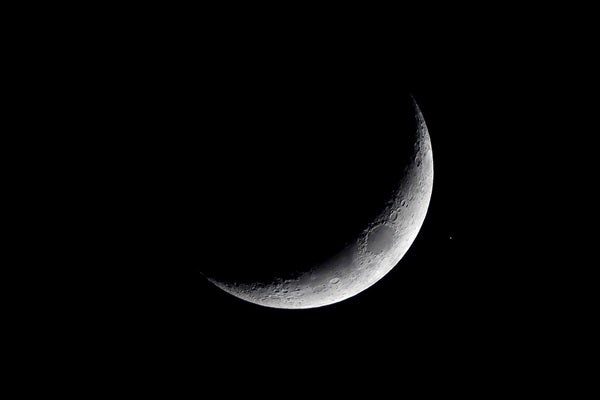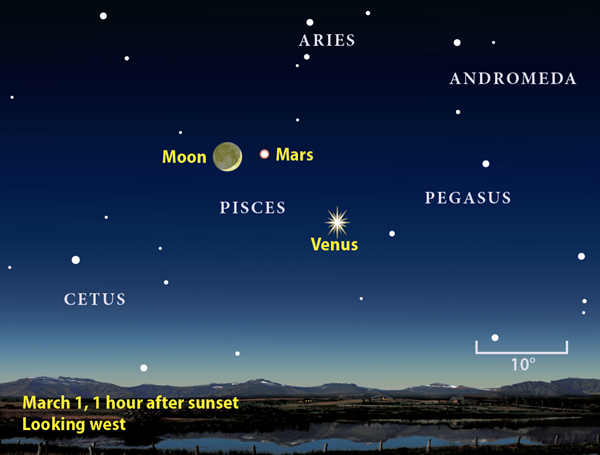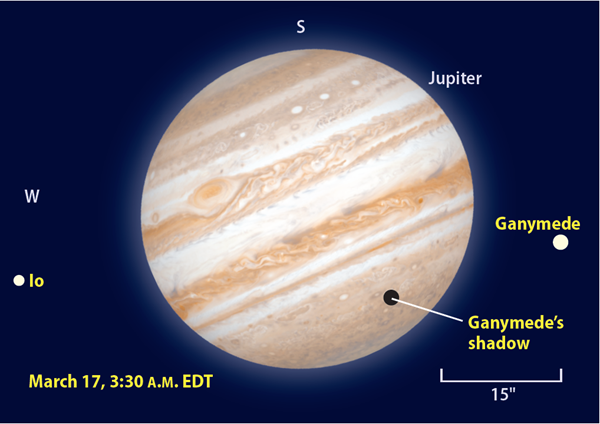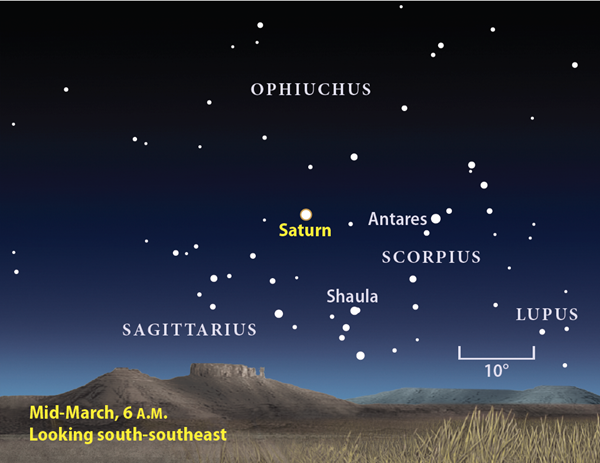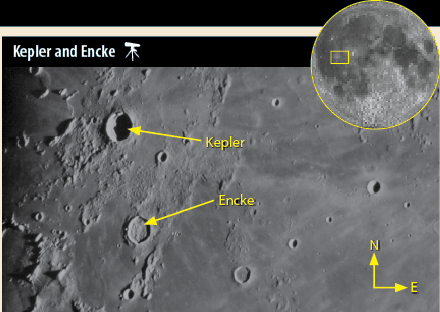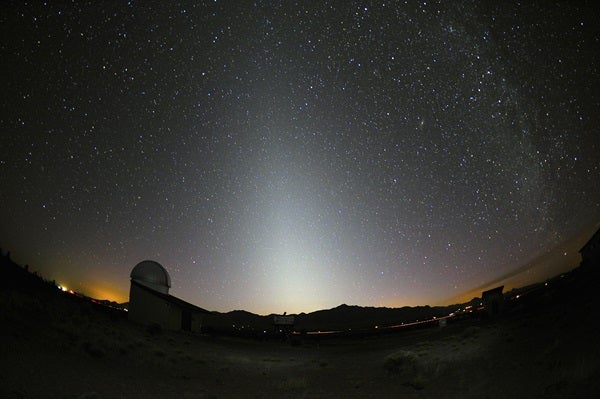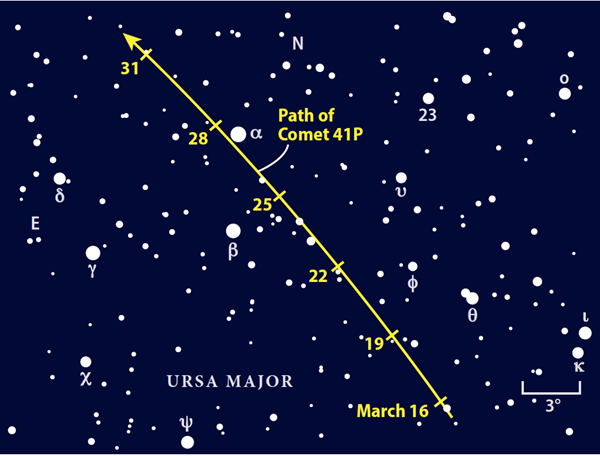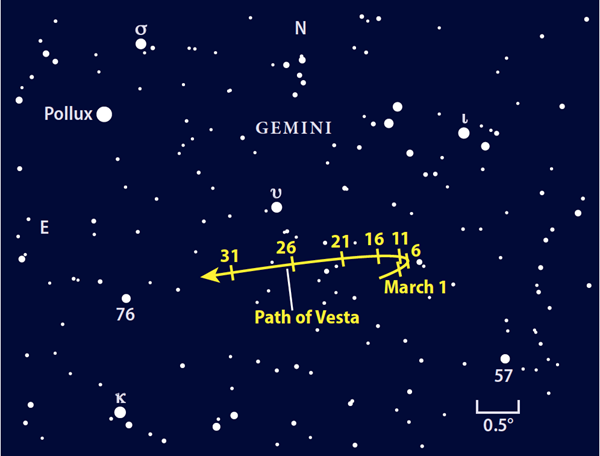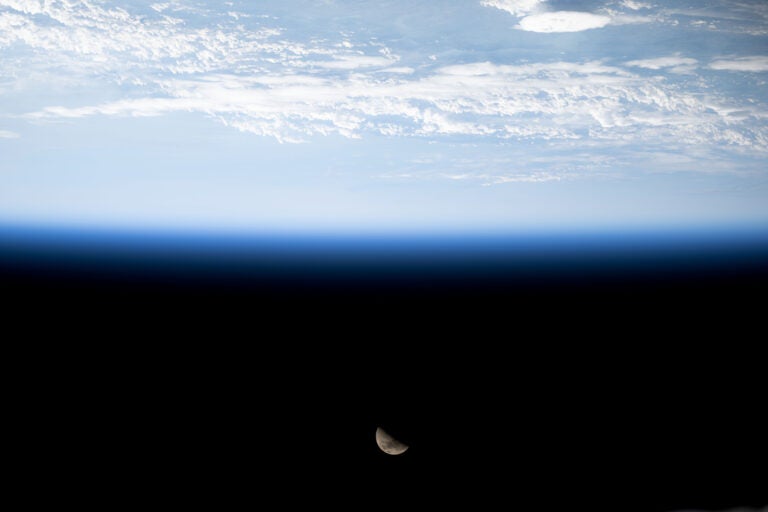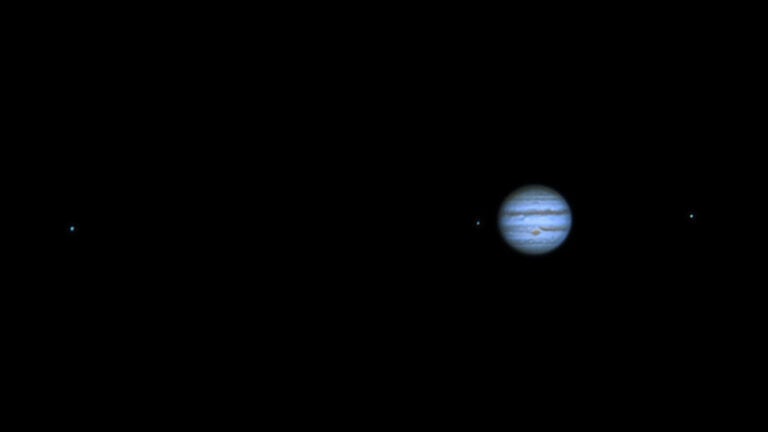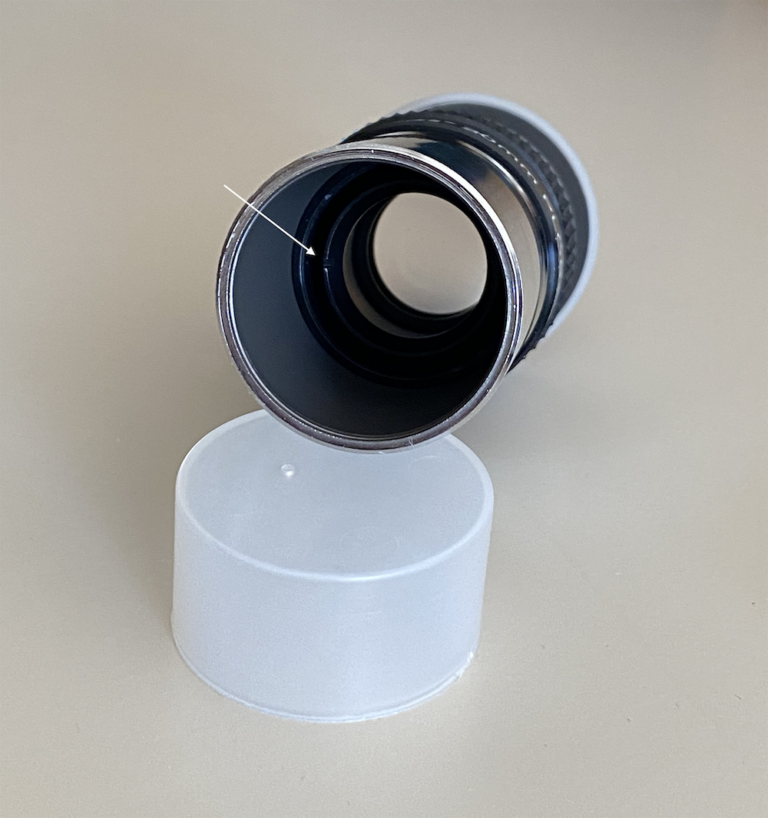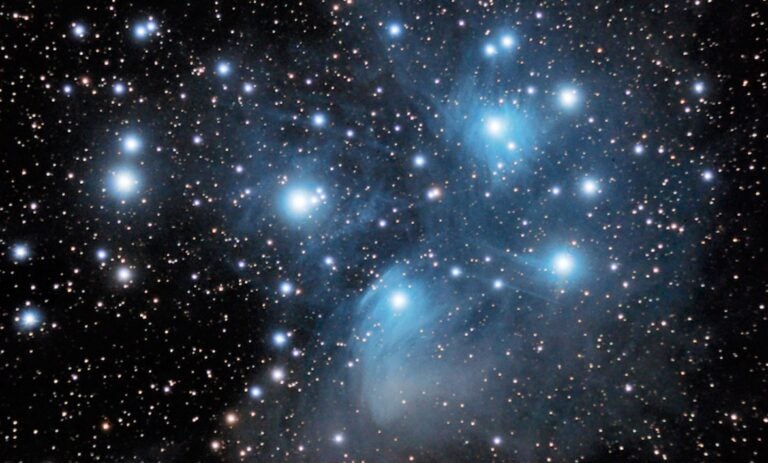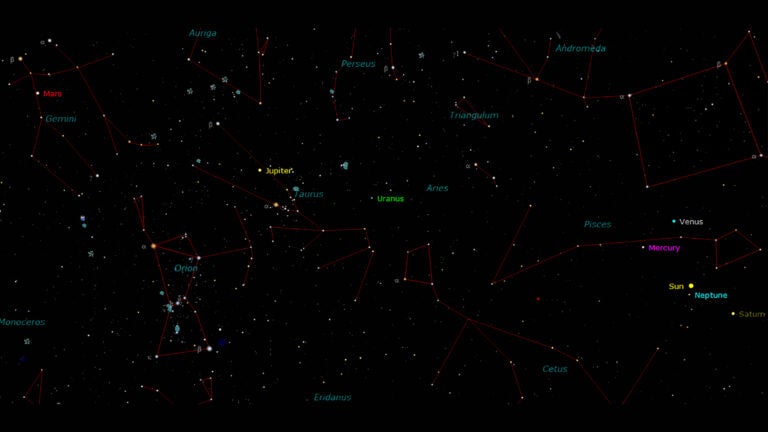his month opens with a stunning view of Venus suspended beneath a crescent Moon in evening twilight. Mars and Uranus join these brilliant objects in the western sky after sunset, but the more distant worlds pale in comparison. The waxing Moon visits Aldebaran on March 4, blocking the 1st-magnitude star from view across most of the United States. And Mercury begins its best evening appearance of 2017 in late March.
Jupiter climbs into view later in the evening, and it remains a fine sight until dawn. It shares the early morning sky with beautiful Saturn and, in the month’s final days, Venus on a return visit after having passed between the Sun and Earth.
Our night sky tour begins after sundown March 1. Although the crescent Moon will grab your attention first, you can’t help but see Venus, too. The brilliant “evening star” shines at magnitude –4.8 and shows up easily within a half-hour after sunset. It remains on view until about 8:30 p.m. local time, offering more than an hour of observing time after twilight ends.
Venus doesn’t stick around all month, however. The inner planet’s orbit is carrying it closer to a line joining the Sun and Earth, so it loses altitude each day. On March 1, it stands 20° high an hour after sunset. That drops to 13° a week later and just 4° a week after that. It’s still visible because it shines so brightly (at magnitude –4.4 on the 15th), but you might need an observing site that affords an unobstructed view to the west.
The planet’s telescopic appearance changes in tandem with its orbital movement. As Venus approaches Earth, its apparent size swells and its phase dwindles to a thin crescent as the hemisphere lit by the Sun turns away from us. And these changes happen quickly. On March 1, the inner world spans 48″ and appears 16 percent lit.
One week later, Venus measures 53″ across and shows a 10-percent-lit phase. And the week after that (on the 15th), the disk appears 57″ across while the Sun illuminates only 4 percent of its Earth-facing hemisphere. By this stage, you should be able to discern its large crescent through steadily held binoculars.
Venus reaches inferior conjunction March 25, when it passes most nearly between the Sun and Earth. The inner planet then shoots into the predawn sky, where it becomes visible by month’s end.
Mercury gives an almost mirror-image performance to Venus. The innermost world passes on the far side of the Sun from our perspective (a configuration known as superior conjunction) March 6 before climbing into view after sunset. You can start looking for it around the 20th, when it lies 6° above the western horizon a half-hour after sunset. Mercury shines at magnitude –1.2, bright enough to pierce the twilight glow even at this low altitude, though binoculars can help you to spot it. A telescope reveals the planet’s 5.7″-diameter disk, which appears nearly 85 percent lit.
Observing conditions improve quickly. On the 25th, Mercury stands 10° high at the same post-sunset time. Although it glows fainter then, at magnitude –0.9, the added altitude makes it easier to see. A telescope shows a disk 6.4″ across and two-thirds lit.
On March’s final evening, the diminutive world stands 12° above the horizon a half-hour after sunset and is still 7° high under a much darker sky 30 minutes after that. The magnitude –0.2 planet appears 7.5″ across and 43 percent illuminated when viewed through a telescope. Mercury will reach the peak of this apparition — its best of 2017 — April 1.
The early evening sky’s other two planets, Mars and Uranus, put on more-subdued shows. The two pair up in the western sky March 1, when the Red Planet lies 2° northeast of its neighbor and the crescent Moon stands 4° southeast of Mars. All three objects appear in the same field of view through 7×50 or 10×50 binoculars. Place the Moon on the field’s left side, find magnitude 1.3 Mars to its right, and then search for Uranus 2° directly below the ruddy world. Uranus glows at magnitude 5.9 and should show up easily if you have a transparent sky.
Mars remains an evening fixture throughout March. It crosses from Pisces into Aries on the 8th and traverses more than half the latter constellation by month’s end. This rapid eastward motion keeps Mars well ahead of the Sun and visible long after darkness falls throughout March. A crescent Moon returns to its vicinity on the 30th.
Uranus does not fare as well. It dips into the twilight glow after midmonth and won’t return to view until mornings in late spring.
The Moon calls attention to several planets as it parades through the evening sky in March. But our satellite also heralds a few noteworthy stars. On the 1st, attentive observers in North America’s eastern half will see the Moon pass in front of (astronomers say “occult”) magnitude 4.4 Nu (ν) Piscium shortly after 8:30 p.m. EST.
But this is just a prelude to the main event March 4.That evening, our satellite occults the 1st-magnitude star Aldebaran in Taurus the Bull. Observers across most of the United States, except for those within shouting distance of the Canadian border or in the northern half of New York and New England, can see this event. With Aldebaran bright and the Moon only about 45 percent lit, binoculars will deliver nice views. Of course, a telescope’s more-stable platform yields the best looks.
The occultation begins after 11 p.m. EST on the East Coast and after 7 p.m. PST on the West Coast. Exact times depend on your location (visit www.lunar-occultations.com/iota/iotandx to get accurate predictions). With a telescope, center your field of view on Aldebaran. You probably won’t see the Moon’s dark limb lurking just west of the star. But as Luna’s orbital motion carries our satellite to its stellar rendezvous, Aldebaran will vanish suddenly. It will remain hidden for up to an hour or more (again, it depends on your location) before snapping back into view. The star returns at the bright limb, which makes the reappearance much harder to view.
Jupiter pokes above the eastern horizon around 9 p.m. local time in early March and during evening twilight by month’s end. This early rising time foreshadows the planet’s imminent arrival at opposition, the peak of its yearlong apparition, which will occur in April’s first week. And this means our view of the gas giant in March is close to perfection.
Jupiter brightens from magnitude –2.3 to –2.5 during March. Only the Moon and Venus outshine the solar system’s largest planet. Jupiter appears against the backdrop of Virgo the Maiden, approximately 5° from 1st-magnitude Spica. The constellation’s brightest star pales in comparison, however, appearing less than 5 percent as bright as the planet.
The approach of opposition also means that Jupiter is pulling closer to Earth and thus looming larger when viewed through a telescope. The planet’s equatorial diameter swells from 42″ to 44″ this month. Its polar diameter is 6 percent smaller, however, a difference noticeable even through small instruments.
But the first thing you’ll notice as you focus on Jupiter is its richly detailed atmosphere. The planet’s cloud tops resolve into a series of alternating bright zones and darker belts. Turbulence at the edges of these bands triggers more-subtle features. They show up under good observing conditions, typically after Jupiter climbs 30° above the horizon some three hours after it rises. You get sharper views then because the light travels through less of Earth’s atmosphere.
Whenever you have Jupiter centered in the field, you can’t help but notice up to four pinpricks of light hovering nearby. These are the Galilean satellites: Io, Europa, Ganymede, and Callisto, in order of their orbital distances. Because they circle the planet at different rates, their relative positions change constantly.
The moons’ common orbital plane tilts nearly edge-on to our line of sight, so an individual satellite spends most of its time either east or west of the planet. The three inner ones, however, pass in front of the planet once each orbit and cast a dark shadow on the jovian cloud tops. Half an orbit later, the moon disappears behind the planet.
Innermost Io orbits fastest and thus delivers the most events. All North American observers can see it and its shadow transit the mornings of March 2, 9, 16, and 25. Europa gives a similar show the nights of March 15/16 and 22/23, and again the morning of March 30. For Ganymede, the biggest satellite and the one with the largest shadow, the best-timed events occur the nights of March 9/10 and 16/17. During the latter one, the shadow touches Jupiter’s cloud tops at 2:36 a.m. EDT. The moon itself starts to transit at 4:53 a.m., just 12 minutes before the shadow lifts back into space.
Callisto orbits far enough from Jupiter that it currently doesn’t pass in front of or behind the giant’s disk. The morning of March 13 provides a rare opportunity to see the moon due south of the planet.
While Jupiter dominates the predawn sky during most of March, don’t pass on the opportunity to view Saturn. The ringed planet lies in Sagittarius and rises around 2:30 a.m. local time on the 1st. All month, early rises will be greeted to spectacular binocular views of Saturn among the Milky Way’s rich star fields, with the Lagoon and Trifid nebulae (M8 and M20, respectively) and open star cluster M23 less than 5° away. Saturn stands among them shining at magnitude 0.5.
Predawn views of Saturn and its ring system through a telescope are sublime. The planet’s disk spans 17″ at midmonth while the rings span 38″ and tilt 26° to our line of sight. The rings now protrude above the planet’s north pole, and the planet’s shadow falls on the western side of the rings behind Saturn.
Venus returns to view in the eastern sky before dawn following its March 25 inferior conjunction. By the 31st, the inner planet rises an hour before the Sun and shines brilliantly at magnitude –4.1. When viewed through a telescope, it shows a beautiful 2-percent-lit crescent that spans 58″.
| WHEN TO VIEW THE PLANETS | ||
| Evening Sky | Midnight | Morning Sky |
| Mercury (west) | Jupiter (southeast) | Venus (east) |
| Venus (west) | Jupiter (southwest) | |
| Mars (west) | Saturn (south) | |
| Uranus (west) | ||
It’s hard to hide the lunar crater Kepler. This youthful impact scar stands out near the Moon’s equator, near the eastern shores of the vast Oceanus Procellarum. The deep, 20-mile-wide bowl is round and sharply defined — a smaller version of prominent Copernicus to its east.
Kepler appears half-lit the evening of March 8. The low Sun angle highlights the roughness of the debris ejected during the impact event that formed the crater. Look a bit to its south for the similarly sized Encke. This crater’s rim appears softer and shows the effects from eons of bombardment. Debris from the Kepler impact fills its bowl.
If you return to Kepler a couple of evenings later, you’ll see how the higher Sun angle transforms the roughness and shadows into a bright apron with rays. Procellarum’s dark lava is thinner here, and that allowed the impact to gouge out lighter-hued rock from below. While Kepler appears more prominent thanks to its rays, Encke has all but disappeared. Typically, older craters fade into the background under a high Sun.
Kepler celebrates the German astronomer who developed the laws of planetary motion in the 17th century. Encke honors the 19th-century German astronomer who first calculated the orbit of a short-period comet. Coincidentally, Comet 2P/Encke lies 10° high in the west an hour after sunset in early March.
Late winter and early spring are the best times for Northern Hemisphere observers to spot the zodiacal light after sunset. Viewing conditions peak when the ecliptic — the Sun’s apparent path across the sky — makes a steep angle to the western horizon.
This soft light comes from sunlight reflecting off tiny dust particles in the inner solar system; they concentrate heavily along the ecliptic. It appears somewhat dimmer than the Milky Way, so look for it from a dark site when the Moon is out of the sky (March 14–28 this year) and twilight has faded away. The cone-shaped glow stretches from the horizon up through Taurus.
A close pass by a small (but bright) comet
By the end of March, Comet 41P/Tuttle-Giacobini-Kresak should be a decent sight through binoculars and might even grow bright enough to see with the naked eye. Observers typically aren’t so fortunate. It was a faint object when American astronomer Horace Tuttle first saw it in 1858. After that apparition, it remained hidden until French observer Michel Giacobini spotted it in 1907. But it soon disappeared, and wasn’t recovered until Slovakian astronomer Lubos Kresak stumbled upon it in 1951.
Astronomers were able to pin down its orbit and realized that it revolves around the Sun once every 5.4 years. And yet, people saw it during only three apparitions in nearly a century.
But 2017 looks particularly promising. The comet swings within 13 million miles of Earth in late March, its closest approach yet. And it treks through Ursa Major, so it rides high in the sky for much of the night. The best views should come late in the month when the Moon is out of the sky. The comet then lies near the bowl of the Big Dipper, passing within 1° of magnitude 1.8 Dubhe (Alpha [α] Ursae Majoris) on the evening of the 27th. If predictions hold, it could reach 5th or 6th magnitude.
And we may experience a dramatic outburst. At its 1973 appearance, 41P brightened by 10 magnitudes in one week. It had a five-magnitude outburst during its 2001 return.
Astroimagers should keep an eye on Comet PANSTARRS (C/2015 ER61) as well. On March 1, the 7th-magnitude object sits between the Lagoon and Trifid nebulae in Sagittarius. And on the 8th, it passes 1° north of the bright globular cluster M22.
Pollux points the way to Vesta
March offers asteroid hunting at its easiest. Simply walk outside, point your binoculars at 1st-magnitude Pollux, slide half a field of view to the southwest (lower right), and the second-brightest dot near the field’s center will be 4 Vesta. You can watch the asteroid shift positions relative to the background stars every few nights without having to set up a telescope.
Use the StarDome map at the magazine’s center to locate Gemini’s twin stars, Castor and Pollux. On evenings at this time of year, Pollux lies to its celestial twin’s left. Hold your binoculars steady by leaning against a wall or propping your elbows on the roof of your car. Then, use the trio of 4th-magnitude stars Kappa (κ), Upsilon (υ), and Iota (ι) Geminorum to orient yourself and triangulate to Vesta’s position. The asteroid won’t move much in the first half of March but picks up speed later in the month.
The 325-mile-wide space rock fades from magnitude 7.1 to 7.6 during March, but that’s still brighter than anything in its vicinity except for Kappa, Upsilon, and 5th-magnitude 76 Gem. A telescope shows Vesta more easily, but don’t expect to see any details.

